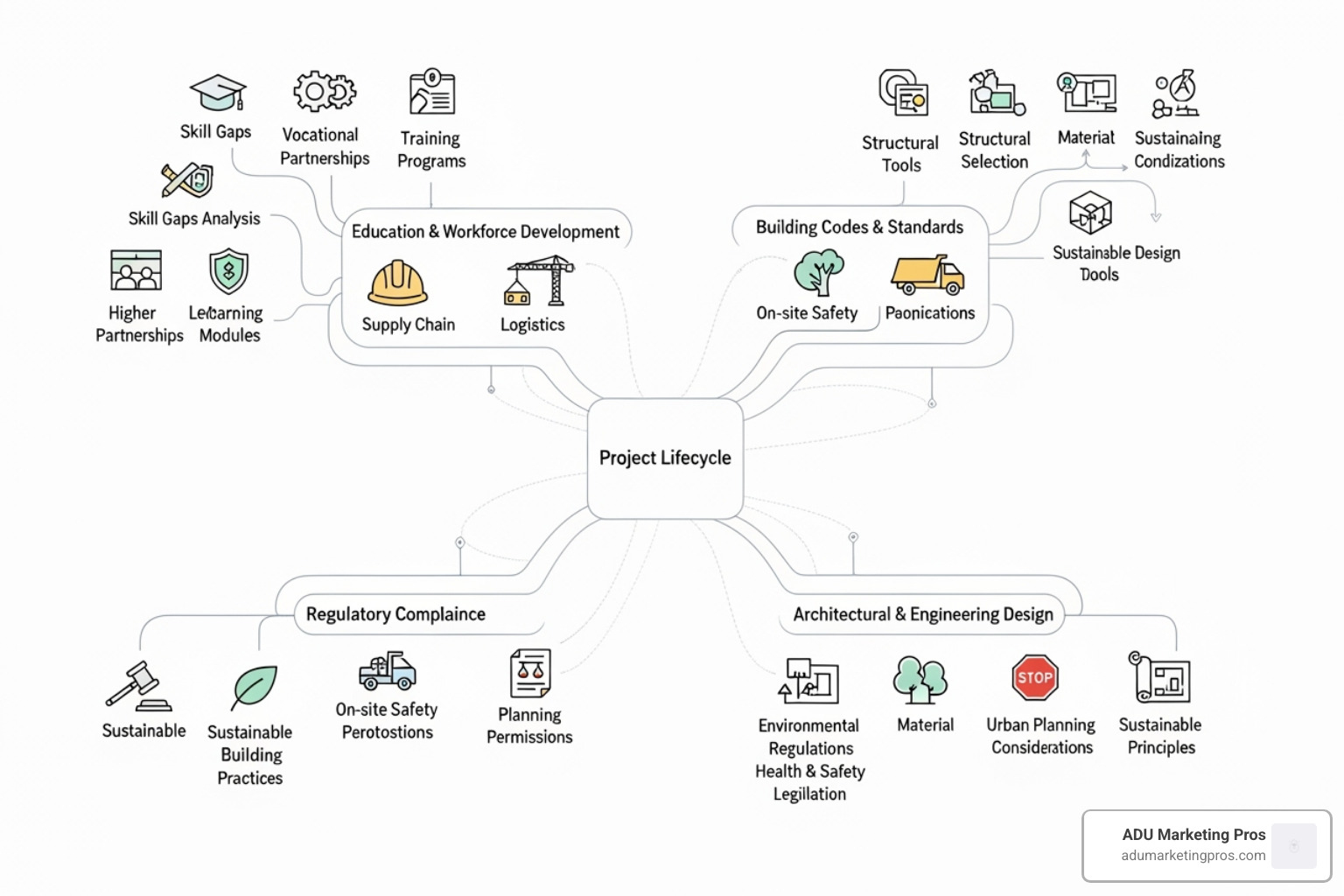Why the ADU Industry Needs a Unified Learning System
An adu education engine is a comprehensive learning platform for ADU professionals—builders, architects, and marketers—to stay current with regulations, construction methods, and marketing strategies in the rapidly evolving accessory dwelling unit industry.
Quick Answer: What You Need to Know
- Definition: A centralized knowledge hub with courses, tools, and AI-powered resources for training ADU professionals and educating clients.
- Core Components: A digital curriculum, a learning management system (LMS), AI personalization, and simulation-based practice.
- Who Needs It: Construction firms, architecture practices, and marketers serving the ADU market.
- Key Benefits: Ensures compliance with changing codes, reduces project errors, accelerates client education, and creates a competitive advantage.
California’s ADU market is booming, but the industry faces a significant and growing knowledge crisis. Regulations don’t just change annually; they can shift month-to-month as cities and counties adapt state laws like AB 1033 (allowing the separate sale of ADUs) or SB 9. A builder who relies on last year’s understanding of setback requirements or height limits is a builder who risks costly project delays and client disputes. The old model of scattered blog posts, informal word-of-mouth knowledge sharing, and occasional workshops is no longer sufficient to manage this complexity.
Your team needs current, verified information delivered consistently in a format they can access and use on the job. That’s where the ADU education engine concept comes in. It’s not just another training program; it’s a systematic, ongoing approach to building and maintaining expertise across your entire organization. Think of it as the essential infrastructure that powers continuous learning and operational excellence. An education engine is a dynamic system that actively converts scattered, often contradictory information into practical, actionable knowledge your team can apply immediately. The firms winning in this market aren’t just building better ADUs; they’re building better, more resilient learning systems. This guide will show you how to design and build your own.
What is an ADU Education Engine?
In the fast-moving ADU industry, where a single missed code update can derail a project, continuous learning is essential for staying competitive and profitable. An adu education engine solves this challenge by providing a centralized, dynamic knowledge hub for your entire team—from builders and architects to designers and sales staff.
Unlike a one-time training event or a static folder of PDFs, it’s an active, living system for continuous skill development. It ensures your team has the right information at the right time, whether it’s a project manager needing a last-minute code check before a client meeting, a designer exploring new sustainable materials, or a sales consultant reviewing financing options on-site with a homeowner. This on-demand, context-aware access is the core power of a well-designed education engine. It transforms training from a passive requirement into an active tool for problem-solving and innovation.

The Core Curriculum: Essential ADU Knowledge
Every education engine needs a solid, up-to-date curriculum covering the fundamentals every ADU professional must master. This content should be modular and easily searchable.
- ADU Building Plans: This goes beyond basic blueprint reading. It includes modules on structural engineering principles for small structures, space-efficient design, universal design concepts for accessibility, and integrating sustainable materials and systems.
- California ADU Regulations: A critical, constantly updated module. It should break down state-level mandates and provide a searchable database of local ordinances for key service areas, covering everything from owner-occupancy rules to parking requirements.
- ADU Building Costs: This module teaches robust cost estimation, including detailed breakdowns of hard costs (materials, labor) and soft costs (permits, design fees). It should include tools and checklists for creating accurate bids and managing project budgets to maintain profitability.
- ADU Financing Options: Your team must be fluent in the various ways clients can fund their projects. This includes training on renovation loans, cash-out refinances, HELOCs, and emerging fintech solutions, enabling them to guide clients to the best options.
- ADU Permit Process: A step-by-step guide to navigating the bureaucratic maze. This module should include checklists, document templates, and walkthroughs for specific city planning department portals, demystifying the process for both your team and your clients.
- ADU Marketing Strategies: This covers modern digital marketing tactics, including local SEO, content marketing to attract qualified leads, and social media strategies. It also trains the sales team on consultative selling and how to articulate the firm’s unique value proposition.
The Delivery System: Learning Management
Great content is useless if it’s buried in a shared drive or difficult to access. A Learning Management System (LMS) is the operational backbone of your education engine, delivering content, tracking progress, and fostering a culture of learning.
A modern LMS provides a blended learning experience with features that drive engagement and retention:
- On-Demand Access: Short, focused micro-learning modules that professionals can access on a tablet at a job site or on a laptop between meetings.
- Interactive Content: Beyond text, this includes video tutorials, interactive checklists, digital resources, e-books, and virtual labs that make learning engaging and practical.
- Progress Tracking & Certification: Tools for learners to see their advancement and for managers to ensure compliance and identify knowledge gaps. Issuing internal certifications for completing key modules can motivate staff.
- Assessments: Quizzes, scenario-based questions, and assignments to verify that knowledge has been retained and can be applied correctly.
- Collaboration Tools: Features like discussion forums, messaging, and video conferencing that create a learning community. This allows team members to share real-world experiences, ask questions, and solve problems together, turning individual knowledge into organizational wisdom.
A well-designed LMS scales with your firm, adapting to your needs as you grow from basic onboarding for new hires to advanced, specialized training for senior staff.
Powering Your Learning: The Role of AI in an ADU Education Engine
Artificial Intelligence transforms an adu education engine from a static library into a dynamic, intelligent learning companion. AI doesn’t just store information; it understands context, adapts to individual needs, and creates learning experiences that are smarter, faster, and more effective. In the ADU industry, where regulations, materials, and client expectations evolve constantly, this AI-driven adaptability is a key to survival and market leadership.

Personalizing the Learning Experience
Traditional one-size-fits-all training often fails because it bores experienced professionals and overwhelms newcomers. AI-driven personalization shatters this outdated model by creating custom learning paths tailored to each person’s role, experience level, and identified knowledge gaps. For instance, a veteran architect might receive a concise update on new fire-resistant material codes, while a new project coordinator receives a comprehensive, step-by-step introduction to the entire ADU lifecycle.
This personalization extends to real-time support. AI-powered chatbots can act as instant compliance checkers, answering specific code questions like, “What is the maximum height for a two-story ADU in San Jose?” Virtual assistants can guide users through the complex ADU Permit Process for a specific jurisdiction, prompting them for the right forms and information at each stage. The system adapts, offering more scaffolding and support to those who struggle and presenting advanced scenarios to those who excel. For those interested in a deeper dive into the pedagogy, programs like Ontario Tech University’s Artificial Intelligence in Teaching and Learning Certificate explore these applications in depth.
Enhancing Skills with AI-Powered Simulation
Reading about a complex client negotiation or a tricky construction challenge is one thing; practicing it is another. Simulation-Based Learning (SBL) powered by AI is a game-changer, creating realistic, interactive environments where your team can practice complex skills without real-world risk.
Imagine these scenarios:
- A project manager navigates a virtual ADU project with unexpected challenges thrown in by the AI, such as a sudden material shortage or a subcontractor delay, testing their problem-solving skills.
- An architect practices a permit submission for a property with unusual zoning, getting immediate AI feedback on compliance errors before the official submission.
- A sales team member role-plays with an AI-powered “client” avatar that raises common objections about cost, timelines, and disruption, allowing them to hone their communication and negotiation skills.
These simulations allow for learning from mistakes when the stakes are low, building confidence and competence. The AI can dynamically adjust the difficulty of the simulation based on the user’s performance, ensuring everyone is learning at the edge of their ability, which is where the fastest growth occurs.

Ethical Considerations and Best Practices
Using AI in an adu education engine is a powerful tool, but it requires careful attention to ethics and responsible implementation. Trust is paramount, and it can be easily broken.
- Data Privacy: The system will collect data on employee performance and knowledge gaps. It is fundamental to have clear policies on how this data is stored, used, and anonymized to protect personal privacy and maintain trust.
- Algorithmic Bias: AI models are trained on data, and if that data contains historical biases (e.g., designs that don’t consider accessibility, or marketing data that overlooks certain demographics), the AI can perpetuate and even amplify those biases. Regular audits of AI tools and their outputs are necessary to ensure fairness and equity.
- Inaccuracy and Hallucinations: AI, especially generative AI, can make mistakes or “hallucinate” incorrect information. This is extremely dangerous when dealing with building codes or safety regulations. All AI-generated content, especially compliance-critical information like ADU Guidelines Los Angeles, must be subject to human oversight and validation by a qualified expert.
Best practices involve being transparent with your team about how AI is being used, maintaining a human-in-the-loop for critical decisions, and leveraging AI to support accessibility and differentiated instruction for all learners. The ultimate responsibility for using AI wisely and ethically remains firmly human.
Practical Applications for ADU Professionals
An adu education engine is not a theoretical concept; it’s a practical, role-specific tool that delivers tangible benefits by providing training that professionals can immediately apply to their daily work. It recognizes that a builder on a job site, an architect in the design studio, and a marketer developing a campaign face vastly different challenges and require distinct knowledge and skills.
For Builders and Construction Firms
For teams in the field, information must be accessible, accurate, and immediately applicable. An adu education engine moves training from the classroom to the job site, directly improving project outcomes.
- Project Management Excellence: On-demand modules and simulations on ADU-specific project scheduling, managing subcontractor timelines, and resource allocation. This includes training on using project management software to track progress against budgets and deadlines in real-time.
- Enhanced Safety Training: Interactive virtual scenarios that go beyond static presentations. Trainees can practice responding to simulated on-site hazards, like identifying an unsafe trench or properly handling a chemical spill, making safety protocols more memorable and effective.
- Cost and Bidding Accuracy: Access to AI-powered tools and historical project data to better predict ADU Building Costs. This leads to more competitive, profitable bids and reduces the risk of budget overruns that can damage client relationships and firm reputation.
- Superior Client Communication: Training modules focused on building trust, managing expectations, and providing clear, consistent updates to homeowners. This helps convert more ADU Construction Leads into signed projects and generates positive reviews.
This modern, data-driven approach to training makes your entire operation more efficient and competitive, a key selling point when working with an ADU Construction Marketing Agency to promote your business.
| Feature | Traditional Training | AI-Powered ADU Education Engine |
|---|---|---|
| Accessibility | Scheduled classes, physical manuals | On-demand modules, 24/7 mobile access |
| Personalization | One-size-fits-all curriculum | Adaptive learning paths by role & skill |
| Engagement | Passive lectures, static presentations | Interactive simulations, gamification, quizzes |
| Feedback | Delayed, general, often peer-based | Immediate, specific, performance-based |
| Cost | High per-person, recurring travel/time | Scalable, lower long-term cost, less downtime |
For Architects and Designers
Architects and designers are in a constant balancing act between creative vision and regulatory constraint. An adu education engine provides critical support to enhance both creativity and compliance.
- AI-Powered Idea Generation: Tools that analyze thousands of successful ADU Building Plans to suggest layout options, material palettes, and design approaches based on site constraints, client budget, and desired aesthetic. This augments, rather than replaces, the architect’s creativity.
- Real-Time Regulatory Compliance: An AI-powered compliance checker that provides instant feedback on designs against California ADU Regulations and specific local codes, flagging potential issues with setbacks, height, or lot coverage early in the design process, saving countless hours of revisions.
- Immersive Client Visualization: Training on using advanced 3D rendering and virtual reality walk-throughs. These tools help clients visualize and experience their space before construction begins, allowing them to make confident decisions and significantly reducing costly change orders during the build phase.
- Effective Communication and Documentation: Guidance on crafting clear, compelling proposals for clients and meticulously detailed technical documents for the ADU Permit Process, ensuring smoother approvals.
These capabilities are not just internal efficiencies; they become powerful differentiators for your ADU Builder Marketing Strategy.
For Marketers and Sales Teams
For marketing and sales professionals, deep product and process knowledge is crucial for connecting with clients, building trust, and closing deals in a competitive landscape. An adu education engine equips them to be true consultants, not just order-takers.
- Deep Understanding of Client Needs: Training modules on the different homeowner personas and their motivations for building an ADU (e.g., rental income, multi-generational living, aging in place). This allows for a more empathetic and customized sales approach.
- Advanced Lead Generation and Nurturing: Learning the most effective digital tactics for ADU Lead Generation, including hyper-local SEO, targeted social media advertising, and creating email nurturing sequences that guide prospects through their decision-making journey.
- Crafting Effective and Empathetic Messaging: Training on how to clearly articulate the firm’s value proposition and confidently address common homeowner concerns about ADU Building Costs, financing, and the perceived complexity of the ADU Permit Process.
- Data-Driven Market Analysis: Access to a dashboard with current market data, competitor activity, and housing trends. This keeps your ADU Marketing Strategies sharp, relevant, and targeted.
This deep knowledge makes ADU Marketing Made Easy: Tips to Promote Your Accessory Dwelling Unit a reality, helping your firm stand out as a trusted authority in a crowded market.
Building Your Firm’s ADU Education Engine
Creating your own adu education engine is a strategic investment that fundamentally transforms how your team learns, performs, and how your business stands out. It’s a project that should start with a solid, scalable foundation and evolve over time. The process of building this system also creates valuable intellectual property and resources that position your firm as a trusted authority, a core principle of a successful ADU Marketing Agency strategy.

Step 1: Identify Knowledge Gaps and Core Competencies
Before building anything, you must perform a strategic analysis to understand where your team excels and where they need help. This audit will be the blueprint for your content strategy.
- Survey your team: Use anonymous surveys to ask staff what parts of the ADU process are most confusing, stressful, or time-consuming. Ask what they wish they knew more about.
- Listen to your clients: Systematically track and categorize the questions clients ask most frequently. Recurring questions about topics like ADU Financing Options or the timeline for the ADU Permit Process are clear indicators of a knowledge gap that needs to be filled.
- Review past projects: Conduct post-mortems on completed projects. Analyze where delays, budget overruns, or client dissatisfaction occurred. These pain points are often symptoms of underlying training needs.
Common gaps often include confusion over nuanced local zoning codes, difficulty estimating soft costs for ADU Building Costs, and inconsistent client communication across the team.
Step 2: Curate and Create High-Value Content
With your knowledge gaps identified, you can begin building your content library. A common mistake is thinking you must create everything from scratch. A smarter approach blends curation and creation.
- Curate existing resources: Start by gathering, organizing, and annotating high-quality guides, official documents, and webinars on topics like California ADU Regulations from government and authoritative industry sources. Your value is in vetting and contextualizing this information for your team.
- Create proprietary content: This is where you codify your competitive advantage. Document your firm’s unique processes, design philosophies, project management checklists, and hard-won lessons. This is your secret sauce.
- Use engaging multimedia: People learn in different ways. Develop short video tutorials demonstrating a complex construction technique, create interactive checklists for site inspections, and record audio interviews with subject matter experts on your team.
- Develop detailed case studies: Document your successful projects from start to finish. These serve as powerful internal training material on process and problem-solving, and they can be repurposed as compelling content for your Accessory Dwelling Unit (ADU) Marketing.
This strategic approach turns your internal training investment into a valuable library of ADU Educational Content that also attracts and educates potential clients.
Step 3: Choose the Right Technology Stack
Your technology platform is the foundation that makes your adu education engine accessible and effective. The key is to start simple and choose a system that can scale with your ambitions.
- Select a modern LMS: Choose an intuitive, cloud-based Learning Management System (LMS) that offers mobile access, progress tracking, assessments, and robust reporting. Look for systems that are easy for administrators to update and for users to navigate.
- Integrate AI and collaboration tools: Select a platform with built-in AI features or the ability to seamlessly integrate with third-party AI tools and your existing communication platforms like Slack or Microsoft Teams. Secure integration is key, a principle seen in enterprise systems like the Cloud Identity Engine.
- Prioritize analytics and measurement: Your platform must have strong analytics capabilities. You need to track course completion, assessment scores, and user engagement to understand what’s working and what’s not.
Step 4: Launch, Measure, and Iterate
An education engine is not a “set it and forget it” project. Its value comes from continuous improvement.
- Start with a pilot program: Roll out the engine to a small, enthusiastic group of employees first. Gather their feedback to work out any kinks before a company-wide launch.
- Measure ROI: Use the platform’s analytics to track impact. Correlate training on ADU Lead Generation with actual lead conversion rates. Track whether training on cost estimation reduces budget variances. This data proves the engine’s value to leadership and justifies further investment.
- Establish a feedback loop: Create a simple process for team members to suggest new content, report outdated information, and share what they’ve learned. This makes them co-owners of the system and ensures it remains relevant and valuable.
Frequently Asked Questions about the ADU Education Engine
How can a small ADU firm afford to build an education engine?
Building an adu education engine doesn’t require a massive upfront investment. It’s scalable. A small firm can start lean and build momentum over time by following these steps:
- Curate Free Resources: Begin by creating an organized digital library of existing government guides on California ADU Regulations, articles from reputable sources like the American Institute of Architects (AIA), and manufacturer installation guides.
- Create Simple, High-Impact Guides: Start by documenting your most critical internal processes. Develop your own checklists for the ADU Permit Process or a standard client onboarding sequence. Use simple tools like Google Docs or video recorded on a smartphone.
- Use Low-Cost Software: Start with affordable or free Learning Management Systems (LMS) and collaboration tools like Slack or Trello. You don’t need an enterprise-level system on day one.
- Repurpose Everything: Use client-facing educational content, like a blog post explaining ADU Building Costs, as internal training material. A detailed project case study created for marketing can be a powerful training tool for project managers.
What is the single biggest benefit of using AI in ADU education?
The single biggest benefit is intelligent personalization at scale. AI tailors vast and complex information—like zoning laws, material specifications, or design options—to a specific project context or a user’s individual knowledge level. This saves an immense amount of time, reduces the cognitive load on professionals, and dramatically reduces the chance of human error. For example, instead of a designer manually cross-referencing a blueprint with a 100-page PDF of local codes, an AI can instantly analyze the design and flag that the proposed eaves are 6 inches too close to the property line according to the specific ADU Guidelines Los Angeles for that particular lot. This makes learning far more efficient and directly applicable.
How do we measure the ROI of an ADU education engine?
Measuring the Return on Investment (ROI) is crucial for justifying the continued investment. You can track both qualitative and quantitative metrics, including:
- Efficiency Gains: Measure reductions in the time it takes to complete specific tasks, such as preparing a permit package or generating a project estimate.
- Error Reduction: Track the number of change orders, failed inspections, or budget overruns. A decrease in these metrics after targeted training demonstrates a clear ROI.
- Sales and Marketing Effectiveness: Correlate sales team training with metrics like lead-to-client conversion rates or average project value.
- Employee Retention and Satisfaction: A strong training program is a major benefit. Track employee turnover rates and use surveys to gauge satisfaction with professional development opportunities.
How do we keep the content in our education engine constantly updated?
This is a critical challenge and requires a systematic approach. Designate a “content champion” or a small committee responsible for content freshness. Implement a multi-pronged strategy: subscribe to municipal planning department newsletters, use services that track legislative changes, and build a feature within your engine where any team member can easily flag outdated content. Schedule quarterly reviews of your most critical content, especially modules on regulations and building costs, to ensure they reflect the latest information.
Is an “ADU education engine” just for professionals?
No. While it’s a powerful professional development tool, one of its most strategic uses is for educating homeowners. You can create a client-facing portal using the same platform, providing them with curated information on the ADU permit process, what to expect during construction, and decision-making guides for finishes and fixtures. This transparency builds immense trust, reduces client anxiety, and leads to smoother projects with fewer misunderstandings. An informed client is a better partner, which strengthens the relationship and serves as a powerful marketing tool that generates referrals.
Conclusion
The accessory dwelling unit industry is dynamic, complex, and ripe for innovation. For firms operating in the competitive landscapes of Los Angeles, San Diego, the Bay Area, and across California, staying ahead means more than just building great ADUs; it means continuously building and refining knowledge. The adu education engine concept is not a future-state luxury; it is an essential strategic asset for today. It represents a shift from ad-hoc training to a unified, intelligent, and continuous approach to learning that empowers your team, streamlines operations, reduces risk, and educates your clients.
By embracing this concept, ADU firms can create a powerful and sustainable competitive advantage. An investment in a learning engine is an investment in quality, efficiency, and scalability. We’re not just preparing for a future where AI is increasingly integrated into our work; we’re actively shaping that future within our industry. By building better learning systems, using AI for intelligent personalization and risk-free simulation, and ensuring our teams are always operating at the peak of their performance, we build more resilient and profitable businesses.
At ADU Marketing Pros, we believe that an educated team is an empowered team, and an educated client is a satisfied, confident partner. This philosophy is at the heart of long-term success. We are here to help you develop the strategies to leverage your internal expertise into compelling ADU Educational Content that not only trains your staff but also attracts, nurtures, and converts high-quality leads. Let’s work together to build an adu education engine that fuels your firm’s growth and solidifies your position as an undisputed leader in the ADU market.




